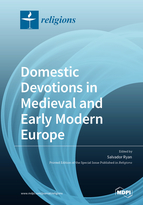Domestic Devotions in Medieval and Early Modern Europe
A special issue of Religions (ISSN 2077-1444).
Deadline for manuscript submissions: closed (15 December 2019) | Viewed by 106631
Special Issue Editor
Interests: late medieval and early modern Christianity; popular religion; lived religion; materiality of devotion; devotion to Christ’s passion; bardic religious poetry; hagiography; history of preaching; medieval exempla; catechisms and their use; sacred history; 19th and 20th century prayer books; relationship between popular piety and liturgy from the Middle Ages to the present day; Irish religious folklore
Special Issues, Collections and Topics in MDPI journals
Special Issue Information
Dear Colleagues,
This Special Issue of Religions will focus on lived religion and devotional practices as found in the domestic settings of medieval and early modern Europe. More particularly, it will investigate to what degree the experience of personal or familial religious practice in the domestic realm and the more public expression of faith in liturgical or communal settings intersected.
In choosing this theme, this Special Issue wishes to build on the significant research that has been undertaken in recent years on domestic devotion in the early modern period, most notably the volumes produced by the ERC-funded interdisciplinary project Domestic Devotions: The Place of Piety in the Italian Renaissance Home, but also in other studies such as Jessica Martin and Alec Ryrie (eds), Private and Domestic Devotion in Early Modern Britain (Farnham: Ashgate, 2012) and Domestic Devotions in Early Modern Italy, ed. Maya Corry, Marco Faini and Alessia Meneghin (Leiden: Brill, 2018). More broadly, in 2014 the Ecclesiastical History Society chose for its 50th volume of Studies in Church History the theme Religion and the Household, which contains, among others, at least twelve contributions on the early modern period.
The specific topic of medieval domestic devotion has been slower to generate significant treatments such as those mentioned above, although there have been fine edited collections such as Defining the Holy: Sacred Space in Medieval and Early Modern Europe, ed. Andrew Spicer and Sarah Hamilton (Aldershot: Ashgate, 2005), which contain a number of medieval essays, and helpful article contributions by Jennifer Kolpacoff Deane (‘”Medieval Domestic Devotion”, History Compass 11:1 (2013)) and others. This issue aims to respond, in part, to the final section of this article, which sets out some directions for future research. Therefore, it especially welcomes contributors who may wish to consider the relationship between domestic religious practice across medieval Christianity, Judaism and Islam, or to focus in particular on any one of the three faiths. Elisheva Baumgarten’s Practicing Piety in Medieval Ashkenaz (Philadelphia: University of Pennsylvania Press, 2014) and Megan H. Reid’s Law and Piety in Medieval Islam (Cambridge: Cambridge University Press, 2013) serve as excellent exemplars of this kind of study. While certainly welcoming contributions on early modern domestic devotion, it is nevertheless hoped that a significant number of the essays gathered in this collection will shed much-needed light on this topic within the broad field of medieval studies.
This Special Issue also wishes to broaden the geographical range of enquiry: thus, while we welcome contributors writing on Western Europe, articles which examine aspects of domestic devotion in Central and Eastern Europe are particularly encouraged to submit proposals.
Topics which might be covered include: books of hours and their use; the domestication of devotion to public images through the production of printed replicas for households; the construction of sacred space in the home; the use of candles, icons, relics, prayer mats, altars, pilgrimage badges, agnus deis, holy water; the communal reading of religious or devotional texts; the practice of fasting; the recitation of prophylactic prayers and the gestures associated with them; the portrayal of domestic devotion in saints’ lives; didactic tracts and their instructions regarding the practice of faith in the home; the adoption of liturgical elements into domestic religious practice, etc.
Prof. Dr. Salvador Ryan
Guest Editor
Manuscript Submission Information
Manuscripts should be submitted online at www.mdpi.com by registering and logging in to this website. Once you are registered, click here to go to the submission form. Manuscripts can be submitted until the deadline. All submissions that pass pre-check are peer-reviewed. Accepted papers will be published continuously in the journal (as soon as accepted) and will be listed together on the special issue website. Research articles, review articles as well as short communications are invited. For planned papers, a title and short abstract (about 100 words) can be sent to the Editorial Office for announcement on this website.
Submitted manuscripts should not have been published previously, nor be under consideration for publication elsewhere (except conference proceedings papers). All manuscripts are thoroughly refereed through a double-blind peer-review process. A guide for authors and other relevant information for submission of manuscripts is available on the Instructions for Authors page. Religions is an international peer-reviewed open access monthly journal published by MDPI.
Please visit the Instructions for Authors page before submitting a manuscript. The Article Processing Charge (APC) for publication in this open access journal is 1800 CHF (Swiss Francs). Submitted papers should be well formatted and use good English. Authors may use MDPI's English editing service prior to publication or during author revisions.
Keywords
- Late medieval Christianity
- Lived religion
- Domestic devotion
- Materiality
- Icons
- Relics
- Religious art
- Household
- Liturgy
- Hagiography
- Books of hours
- Devotional reading
- History of the emotions






